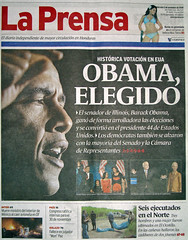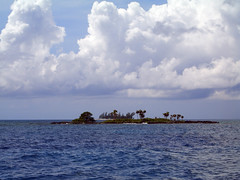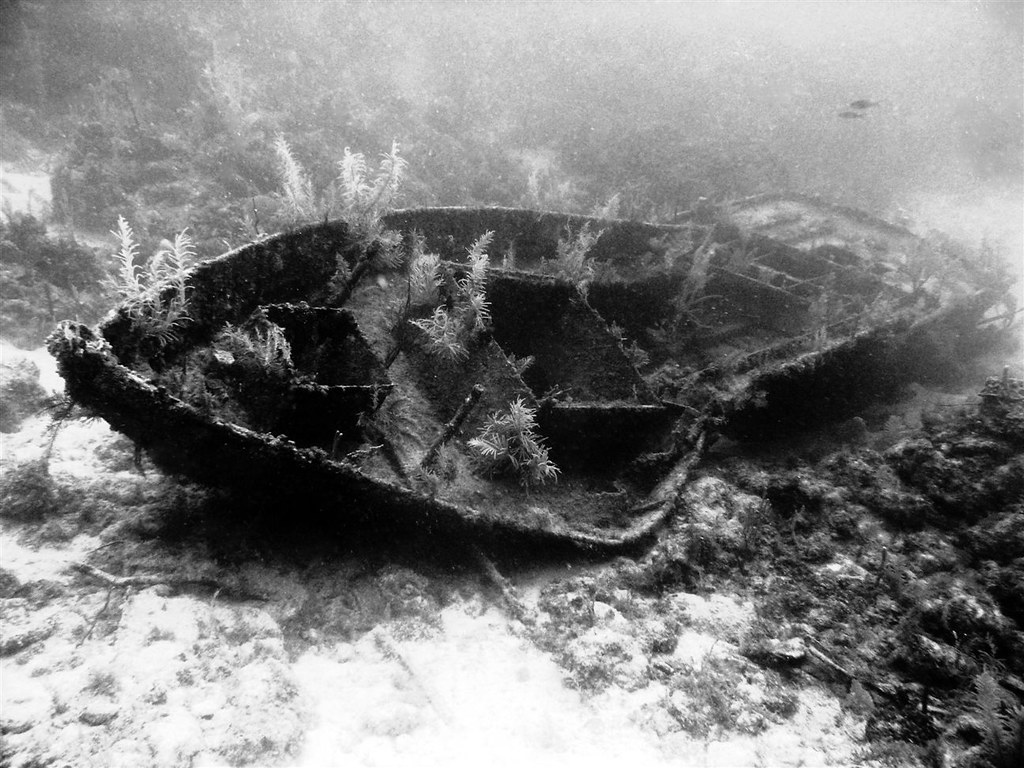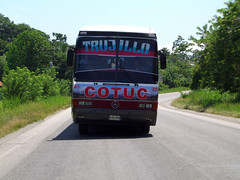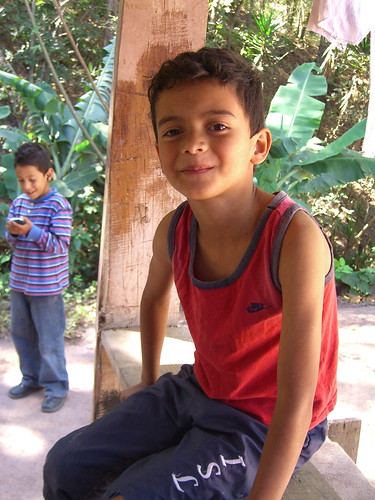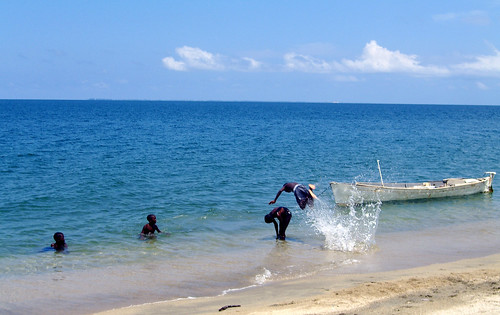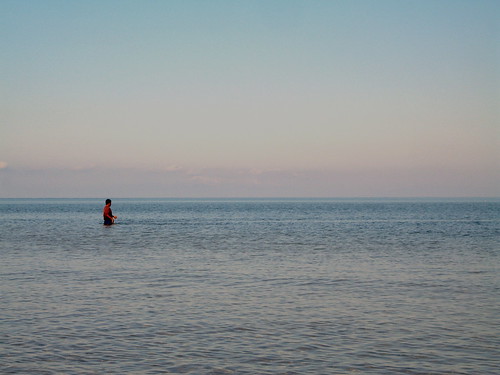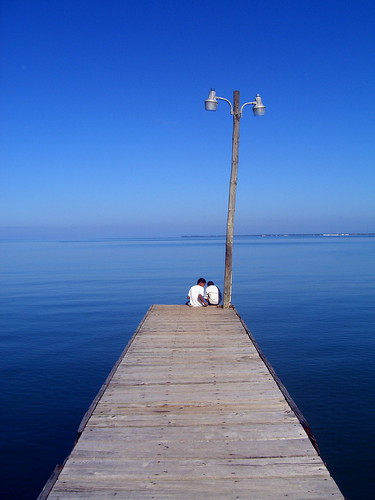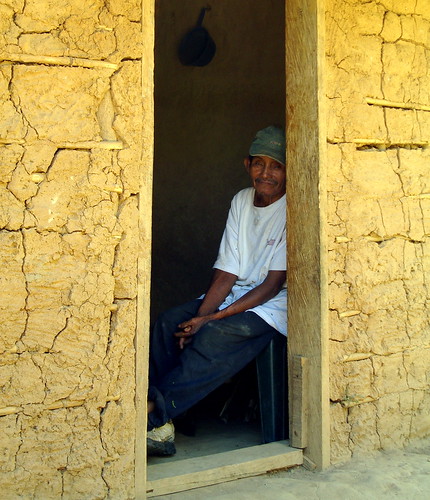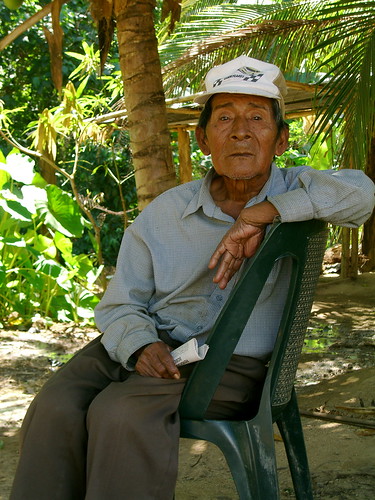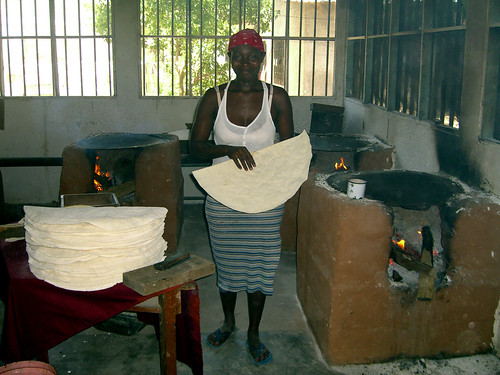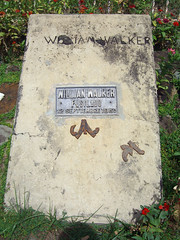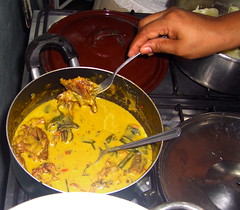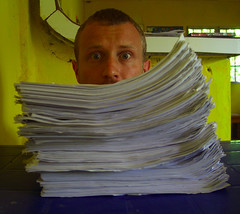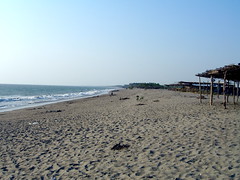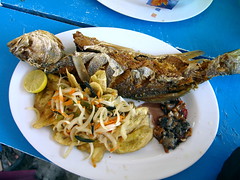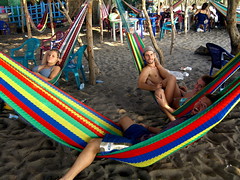Hey everyone, sorry for the long delay in posting. Since my last post I've been traveling a lot. I'm finally back in Trujillo for a good long chunk of time, and will be posting backdated entries to catch up.
First up, Thanksgiving!
For turkey day of 2007, we all got together at Mary's place in Sonaguera. This time, many of the same people (and some newcomers) came all the way out to Trujillo for the feast. And what a feast it was! Helmuth (the project manager for Health, aka my boss) donated a turkey, and Suzie, an expat friend, donated her gorgeous house for us to use for cooking and dining.
Beforehand, some of us prepared thanksgiving-themed decorations including construction-paper turkeys and a paper chain of thanks. (We wrote things we were thankful for on strips of paper and made it into a paper chain.)
The food itself was plentiful and delicious, and much fun was had by all.
Sunday, November 30, 2008
Thanksgiving in Trujillo
Posted by
Raphael
at
11:44 AM
0
comments
![]()
Thursday, November 20, 2008
Soccer Shenanigans
 Honduras is a soccer-crazed nation. How crazed? The only war Honduras fought in the last 100+ years was over soccer. That's about as fanatical as you can get about a sport, I think.
Honduras is a soccer-crazed nation. How crazed? The only war Honduras fought in the last 100+ years was over soccer. That's about as fanatical as you can get about a sport, I think.
Last night Honduras played arch-rival Mexico in the last match of the first round of pool play to qualify for the world cup. This was not an elimination game, but it certainly felt like it. Honduras hasn't qualified for the World Cup in decades, and almost always because they were eliminated by Mexico. On top of that, Mexico habitually insults Honduras, considering them an insignificant team in international competitions.
During the game Trujillo looked like a ghost town. I got dinner from a normally-busy street vendor and was the only customer there. On my way back, Honduras scored a goal and several people came out to fire guns into the air. After a few minutes the streets were empty and quiet once again.
Until the game ended. I was amazed at the scale and energy of the postgame celebrations after Honduras beat Mexico 1-0. Hundreds of people streamed from bars and houses, yelling and chanting, whistling and blowing horns. They sported jerseys, facepaint, honduran flags. Everyone loaded into cars, pickup trucks, dump trucks and anything else with wheels. They formed a parade around the central park. Motorcycles weaved between the larger vehicles and trucks swayed under the mass of humanity that covered them and overflowed from doors, windows and truck beds.
It was quite a sight, and pretty dangerous. In the space of 20 minutes I saw two car accidents (no one hurt, luckily) and one kid fall from the back of a dumptruck and injure himself badly enough that he was taken to the hospital. None of this diminished the celebratory mood, however. A girl I know was in one of the car accidents and just got out and continued celbrating.
I've never seen celebrations in the USA reach such a fevered pitch. Super Bowls and Obama's victory probably come closest.
Posted by
Raphael
at
11:53 AM
3
comments
![]()
Friday, November 14, 2008
Wednesday, November 5, 2008
Honduras and the U.S. Election
I watched the election returns last night with an american, an australian and a salvadorean. Us two americans were glued to the TV set and very emotional about Obama's victory. My other two guests were interested in the elections, but understandably not as emotionally invested. I had a fun time explaining the electoral college to them.
However, there are many Hondurans who are very excited about the elections. I received this text message last night from a friend here in Trujillo:
TE DAS CUENTA
EL MUNDO ES DIFERENTE
¡Change we need!
A dirt road was cleared and repaired yesterday so supplies can be tranported into town. This morning's edition of La Prensa was available at newsstands, and was a hotter commodity than flour, rice, beans or bread. Almost all copies had been sold by the time I got there at 9am. The cover featured a huge color photo of Obama with the headline 'Obama, Elegido'. People were snapping up copies as keepsakes, to show their kids one day. I thought that was remarkable.
It was incredible to see the footage of celebrations across the United States. What most impacted me were the scenes of jubilant strangers hugging, laughing and crying in the streets across the country. I wish I could've been there.
Posted by
Raphael
at
12:45 PM
3
comments
![]()
Sunday, November 2, 2008
Weather damage
There have been rumors flying the last few days about the status of the road and bridges that connect Trujillo to the rest of the country. I have photos of the actual situation thanks to a photographer for La Prensa, and it's not good.
Trujillo is completely cut off and it's still raining.
I'm pretty well-equipped to handle this: I've got plenty of drinking water, food, and cooking gas (which I can use to boil water if I run out of the bottled stuff). The only rough thing is that I don't have running water - I have to capture rainwater for washing, bathing, and toilet-flushing.
Many hondurans have no resources to deal with this kind of disaster. Especially those living in rural communities that have been completely cut off. Thousands of people are homeless and many municipal buildings normally used during emergencies are themselves flooded, exacerbating the problem. It's hard to get any concrete information, though. COPECO, which manages emergencies in Honduras, can't stay on top of everything that's happening.
I'm heading out with a friend from Médicos del Mundo to see the damage for myself. I'll post an update if I learn anything new.
Posted by
Raphael
at
12:16 PM
0
comments
![]()
Wednesday, October 29, 2008
Rain, rain, and more rain
 Honduras rarely gets international news coverage, so when the beeb is talking about us you know it's a big deal.
Honduras rarely gets international news coverage, so when the beeb is talking about us you know it's a big deal.
The rainy season kicked off with a big-ish storm in late September, and it's only gotten worse from there. First there was a Tropical Depression and a low pressure system that collided right over Honduras, causing widespread flooding and landslides. Now there's a cold front dumping rain all over northern Honduras. The road through Tocoa is flooded for the umpteenth time this month, essentially cutting off Trujillo and eastern Colón from the rest of the country.
It's drizzling right now, which is the first time it hasn't poured in about 36 hours. Trujillo is weathering all this pretty well - we're a town built on hills so the water just runs into the bay. But food prices - already up 20 to 40% in the last year - are likely to shoot up as almost all domestic crops have been severely damaged or lost completely.
For the time being, I'm fine. I bought a pair of galoshes and a big umbrella and so I'm able to get to the internet cafe to do work and write blog updates. I'm also spending a lot of time cooking and reading at home. And there is one big benefit from all this rain: it's cold! Highs only in the mid 70's this week. I actually slept with a small blanket last night.
Posted by
Raphael
at
10:31 AM
2
comments
![]()
Monday, October 20, 2008
RPCVs + Honduran Artisans = ArteVida
 When I first arrived in Trujillo 16 months (!) ago, there was already another volunteer here. Brent had been in Trujillo for a year, and helped introduce me to the town and it's people, gave me lots of invaluable advice, and became a good friend.
When I first arrived in Trujillo 16 months (!) ago, there was already another volunteer here. Brent had been in Trujillo for a year, and helped introduce me to the town and it's people, gave me lots of invaluable advice, and became a good friend.
Brent is an RPCV (Returned Peace Corps Volunteer) now, but he still maintains a strong connection to Honduras. Along with two other RPCVs he founded ArteVida, a fair trade arts and crafts store that provides an online marketplace for Honduran artisans. They just had their grand opening, so check them out! Every purchase helps support small business and sustainable development in Honduras.
Posted by
Raphael
at
1:45 PM
2
comments
![]()
Monday, October 6, 2008
lightning strike
Almost identical to last year, this year's rainy season started off with a bang, with a huge multi-day storm in late September. A little over a week ago, I was out in the central park when the storm hit, and lightning started crashing all around us. As soon as the rain let up a bit and the lightning moved off into the distance, I hurried home.
My apartment was filled with acrid electrical smoke when I arrived home. My speakers, fan, and laptop power supply (which I had stupidly left plugged in) were all fried. Until I get a replacement power supply (about 4 weeks or so given honduran shipping times) there probably won't be many blog/foto updates. Just so you know.
My birthday was also this week! Mary, Amanda and I celebrated by watching the VP debate, and cooking lots of good food (including Dr. Dingman's Favorite Pumpkin Pie).
[on soapbox]
In about an hour I leave for La Ceiba to pick up my absentee ballot and vote! I'm very excited about it. Hondurans here are abuzz about the US elections. If you're american, then you have the privilege to affect the outcome of elections that will in turn affect many people all over the globe. Don't take that privilege lightly. Please do your research and vote.
[off soapbox]
That's about it for now. I hope everyone who's reading this is well and good, wherever you are.
Posted by
Raphael
at
9:28 AM
0
comments
![]()
Sunday, September 21, 2008
SCUBA Diving and Útila
The certification takes 3 and 1/2 days, with 1 day of classwork and the rest diving. First we practiced in a shallow area at the dive shop, then we moved on to actual open water dives.
Útila is the most inexpensive place in the world to get your dive certification. We stayed and took the course at Alton's Dive Shop, a really nice, happening place right on the water. It's filled with international travelers and has a very energetic, friendly vibe. If you want to go diving in Útila, I highly recommend it.
Diving itself was a fantastic new experience. Everything about it is fascinatingly different: from breathing underwater, to exploring the bizarre and beautiful plant and animal life of a coral reef, to having complete freedom of motion and virtual weightlessness underwater.
Our last dive of the trip took us to site called Ron's Wreck. There's a sunken sailboat about 17.5 meters underwater. The boat had been taken over by the reef, and was covered in aquatic plants and filled with ocean life. Our instructor told us that there was a giant moray eel living in the stern of the boat, but we didn't see it.
Here are some pictures (not mine) of things we saw diving the reefs of Útila
Posted by
Raphael
at
9:49 AM
1 comments
![]()
A Long Jalón
I'm in Siguatepeque. I need to get to La Ceiba, 4 and 1/2 hours away, by 3pm. I have a ticket for the 9am bus. But now it's 10:30am and the bus hasn't showed. The guy at the ticket counter walks over and explains that the bus has been delayed by strikers in Comayagua who have put up a roadblock on the main highway.
"But the bus will be here soon," he says.
"Are you sure? Do you know when the strike will end?" I ask.
"Well, no, but I'm sure it'll be here soon."
Right.
I relay the information to my travel companions, and we decide to try our luck buscando jalón - hitchhiking. We figure that jaloning (as it's referred to in PCV spanglish) will get us to Ceiba, but probably not in time to make connections to our respective destinations. We know people we can crash with in La Ceiba, so it's no big deal. Strikes, roadblocks and travel delays are so common in Honduras that you just deal with it and don't get too upset.
A half hour later, roasting in the sun, choking on exhaust fumes from dirty trucks whizzing past us, the plan doesn't seem so great. Maybe we should just stay in Siguatepeque and hope the buses can get through tomorrow.
Just then, a tricked-out electric blue extended-cab pickup truck with chrome rims pulls up to us. "Where you goin'?" says the catracho in english with a half-honduran, half-NYC accent.
"Ceiba."
"We're going to Ceiba! Get in!"
"Is there space in the cab for us?"
Riding in the back of a truck is pretty fun for short distances over smooth roads. You get a wide view of the countryside, and are frequently gestured at by honduran drivers amused by seeing a gringo in a paila.
Riding in the back of a truck for nearly 5 hours is exhausting. It's like sitting in a tanning bed during and earthquake while getting blasted by a 200-horsepower blowdryer. But despite the sunburn and dehydration, this was a fantastic jalón. We stopped for a sit-down lunch and still made it to La Ceiba by 3pm.
The guys dropped us off at the mall, and I felt waves of relief as I entered the air-conditioned sanctuary. Two soft-serve ice creams later, the echoes of roaring wind had mostly stopped ringing in my ears and I began to feel human again. That night, I slept for almost 12 hours.
Posted by
Raphael
at
8:06 AM
0
comments
![]()
Saturday, September 6, 2008
Hot Hot Hot
 I took a vacation to the states a couple weeks ago and one of the best things about the vacation (aside from seeing people I love) was the absolutely perfect weather. Always clear, never too hot, never too cold.
I took a vacation to the states a couple weeks ago and one of the best things about the vacation (aside from seeing people I love) was the absolutely perfect weather. Always clear, never too hot, never too cold.
It's been somewhat shocking, to say the least, to return to Honduras and the endless 95 degree days and 90 degree nights with 85% humidity. This year as a whole has been a lot hotter than the last.
The heat really impacts my quality of life. I never stop sweating, and if I forget to drink water constantly then I become dehydrated in no time. I'm going through about 3 liters a day, more when I do a lot of walking around town. I take two cold showers a day but feel dirty and sweaty minutes after toweling dry. It's hard to fall asleep at night, but I still wake up early because my apartment heats up as soon as the sun hits it.
The rainy season comes in a month or two, and I can't wait. In the short term, I leave for a Peace Corps meeting in the much-cooler town of Siguatepeque next Wednesday, and after that I'm going diving off the Bay Island of Útila (hopefully it won't be as hot underwater).
Posted by
Raphael
at
8:03 PM
0
comments
![]()
Thursday, August 28, 2008
Peace Corps Budget Issues?
There have been rumors for some time that the Peace Corps is facing a bit of a budget crunch, but until recently I couldn't find any official mention of a budget shortfalls by Peace Corps officials. The Washington Post recently ran an article detailing the budget crisis.
See also:
- Peace Corps is closing it's Minneapolis recruiting office. Congresswoman Betty McCollum (D-MN) has written a letter to the Director of Peace Corps, Ron Tschetter, asking him to reconsider.
- The Denver recruiting office is also slated to close. The Denver office handles recruiting for five states: Colorado, Wyoming, Nebraska, Utah and Kansas.
- The Peace Corps is closing several smaller posts, including Kiribati.
The consequences of the budget crisis have been felt by PCVs in Honduras. Our living allowances have remained unchanged over the past two years, despite price increases of 20-50% for food and transportation.
Of course, we can manage without getting the extra living allowance. However, Peace Corps is cutting the number of volunteers, closing posts and closing recruiting offices. In order to save costs on training, Peace Corps Volunteers who wish to extend their service are limited to countries where they already speak the language (so Honduras PCVs can no longer extend to Africa, Asia or Eastern Europe). All of these changes result in fewer "boots on the ground." Despite the challenges we face in our communities, I am convinced that Peace Corps Volunteers make a difference at the very least by fomenting understanding and goodwill between the USA and other countries. Fewer volunteers means less goodwill, and the USA doesn't have much of that to sacrifice these days.
Please encourage your senators and congressperson to fully fund Peace Corps.
UPDATE: Erica Burman of the National Peace Corps Association directs us to the MorePeaceCorps campaign, which is advocating for a reinvigorated (and fully funded) Peace Corps.
Posted by
Raphael
at
2:00 PM
6
comments
![]()
Sunday, August 10, 2008
Peace Corps Georgia
 The Third Goal of the Peace Corps is "To help promote a better understanding of other peoples on the part of Americans." So even though this has nothing to do with Honduras, I figure it's worth posting.
The Third Goal of the Peace Corps is "To help promote a better understanding of other peoples on the part of Americans." So even though this has nothing to do with Honduras, I figure it's worth posting.
I've been following the news of the escalating conflict in Georgia for the last couple days, and it finally hit me today: is there Peace Corps in Georgia?
There is. There is also a directory of Peace Corps Georgia Volunteer blogs. Understandably, not many of the blogs have been updated since the fighting began (PCVs have been consolidated to a town near the Armenian border, and may be evacuated to Armenia if the fighting continues.) But there have been some blog entries that provide a personal, and emotional, perspective on what's happening:
"Gori, where Brenden and I lived last summer, was hit by seven more bombs today (there were six yesterday), and the neighborhood of Kombinati (our neighborhood) was particularly hard hit. The bridge between Kombinati and the rest of the Gori is apparently damaged, so the main east-west highway is closed down..." - B & C Go To Georgia
"for those of you looking for updated news, as always, I recommend www.civil.ge and www.alertnet.org" - Cuttino's Blog
"Imagine moving from your home and two weeks after you've left, you're seeing images of the neighborhoods being bombed and buildings that have caught on fire." - Ian MySpace Blog
One of the unsung benefits of Peace Corps is that it creates a network of americans living abroad at the community level. Combined with the Internet, this is a powerful tool for sharing information and perspectives that don't always make the front pages.
Posted by
Raphael
at
7:23 PM
0
comments
![]()
Saturday, August 9, 2008
MSM and Funding for HIV/AIDS Prevention
 The XVII International AIDS Conference ended yesterday in Mexico City. Two leaders from the support group here in Trujillo received funding to attend the conference, and I'm looking forward to hearing all about it from them. In the meantime, an AP article today brought up some issues that are very relevant to combating HIV/AIDS here in Honduras.
The XVII International AIDS Conference ended yesterday in Mexico City. Two leaders from the support group here in Trujillo received funding to attend the conference, and I'm looking forward to hearing all about it from them. In the meantime, an AP article today brought up some issues that are very relevant to combating HIV/AIDS here in Honduras.
In "Global AIDS prevention gives short shrift to gays" reporter Julie Watson writes that "less than 1 percent of the $669 million reported in global prevention spending targets men who have sex with men."
This is despite the fact that "new HIV infections among gay and bisexual men in many countries are rising at alarming rates," and that in many countries the infection rate among men who have sex with men (MSM) is double or triple that of the general population.
In many developing countries, homosexuality is taboo or even illegal. In some places it is punishable by death. Some countries (like Iran) deny that homosexuality even exists. This kind of eyes-closed-and-fingers-in-the-ears denial of reality makes it impossible for public health professionals and institutions to spend prevention resources on one of the populations that most urgently needs it. On top of that, discrimination drives gay and bisexual men underground, making it extremely hard for health workers to reach them.
Ms. Watson goes on to write:
Complicating matters is that in countries from Latin America to Southeast Asia, many men who have sex with men, insist they are not gay. More than 30 percent of Latin American men who reported having sex with men said they also had unprotected sex with women, according to UNAIDS. Many are married.
This is exactly true for Honduras. According to official statistics, nearly 85% of new HIV infections were transmitted through heterosexual contact. In reality, these numbers are almost certainly untrue.
One problem is how the statistics are gathered (when they're gathered at all, which is another huge problem). A person who goes to get tested at a public hospital or health center must fill out a form in which they are asked to state their sexual orientation. This form is filled out in front of the health worker (who is often someone from the same community). Although confidentiality is required by law, it is never practiced. Anyone identifying themselves as gay or bisexual on one of these forms would basically be coming out to their entire community by doing so.
Also, many men who have sex with men never self-identify as homosexual or bisexual. According to machista culture, you're not gay if you're on top, or if you're really drunk. As is stated in the article, most men are married and in many cases don't find out about their own HIV infection until their wives become pregnant and are tested for HIV as part of their prenatal care.
I'd like to say that I know of organizations here that specifically reach out to MSM, but I can't. I'd bet there are some in the larger cities, where homosexuality is more accepted. But in smaller cities and towns, there's nothing. I'm sure that some of the NGOs and GOs that do HIV/AIDS prevention would like to work with MSM, but because it is still so stigmatized here, it's very difficult to reach the population that doesn't want to be discovered.
The article touches upon some strategies for combating HIV among MSM populations. To navigate stigma and taboos, health workers can use sensitive or even coded language in order to ask about homosexual contact without scaring people away. Surveys that quantify infection rates among MSM can help convince public health authorities that action needs to be taken. But most importantly, the stigma and taboos need to be broken down - through education, advocacy and the examples set by those who are willing to go public about their HIV status and their sexuality. We in the support group have focused more on combating the stigma of HIV infection, since on the north coast homosexuality is less stigmatized than in other parts of the country. But I think the support group members who are open about their status and their sexuality have done more to reduce stigma than any public education campaign we might do.
Posted by
Raphael
at
3:56 PM
0
comments
![]()
Friday, August 8, 2008
Help me pick the photos, win a calendar!
Hey folks, some of you may know that the RPCV Madison group puts out a great Peace Corps Calendar every year that features photos submitted by PCVs. They accept up to five photo submissions from each PCV for the calendar. I've gathered some of my best photos and would like you to tell me which five I should submit!
If one of my photos is accepted then I will receive 25 free calendars. Of those, I will give away up to 15 calendars with readers who voted on which pictures to submit! So please look through the following pictures, then add a comment saying which ones you like best (vote for up to five). To get an idea of the kind of photos that get published, you can peruse the winning photos for the 2008 and 2007 calendars.
Thanks for helping me out!
#1) Jairo Smiling:
#2) Oscarito Flying his Kite:
#3) Flips into the Ocean:
#4) Fisherman in the early AM:
#5) Boys Fishing (wide shot):
#6) Pech Family:
#7) Washing by Hand:
#8) Pech man in Doorway:
#9) Pech man on Chair:
#10) Making Casabe:
Posted by
Raphael
at
11:22 AM
7
comments
![]()
Lightning over the Bay of Trujillo
Also, in other random news, the Democratic Party added expansion of Peace Corps to it's draft platform. This should not be construed as an endorsement of the party or as a political statement, it's just news I thought I'd share.
To be "fair and balanced," President Bush did pledge to double the Peace Corps in 2002, resulting in a jump in applications.
Posted by
Raphael
at
10:42 AM
0
comments
![]()
Monday, July 28, 2008
Twitter and Tigo
 I recently started using Twitter, a micro-blogging tool. A cool feature is that you can write updates on your cell phone. Setting up your twitter account to accept updates from a USA cell phone is a breeze, but it wasn't quite as clear how to do it for a Tigo cellphone in Honduras.
I recently started using Twitter, a micro-blogging tool. A cool feature is that you can write updates on your cell phone. Setting up your twitter account to accept updates from a USA cell phone is a breeze, but it wasn't quite as clear how to do it for a Tigo cellphone in Honduras.
So if any of you out there want to Twitter with your Tigo phone, here's how you do it:
1. Sign up for a Twitter account.
2. Go to this page.
3. Enter your phone number using the following format +504XXXXXXXX.
4. Send the confirmation text message to 00447624801423.
5. Check Twitter after a minute or so and your phone should be set up!
You can follow my Twitter updates here.
Thanks to @mangandini and his blog DesdeGuate for help setting this up.
Posted by
Raphael
at
10:50 AM
2
comments
![]()
Thursday, July 24, 2008
Viviendo Positivamente
 Viviendo Positivamente means Living Positively. It's the title of a manual for HIV+ Support Groups produced by Peace Corps volunteers, the 2nd edition of which was revised and updated by Mary and I over the last few months. We're pretty proud of the new edition, and feel that it can be a great tool for support group leaders all over Honduras and probably in other Spanish-speaking countries as well. If you're curious, you can download a copy of it here (approx. 1.5MB PDF).
Viviendo Positivamente means Living Positively. It's the title of a manual for HIV+ Support Groups produced by Peace Corps volunteers, the 2nd edition of which was revised and updated by Mary and I over the last few months. We're pretty proud of the new edition, and feel that it can be a great tool for support group leaders all over Honduras and probably in other Spanish-speaking countries as well. If you're curious, you can download a copy of it here (approx. 1.5MB PDF).
It's also the title of an annual conference organized by Peace Corps for people living with HIV and AIDS (PLWHA) and community health workers who work with PLWHA. Mary wrote a great post about the third annual conference, which happened just a couple weeks ago, so I'll just point you there instead of rehashing it all here. But suffice it to say the conference went really well and we got great feedback from the participants. (The most common answer to our post conference evaluations was "invite me again next year!")
Posted by
Raphael
at
9:09 AM
0
comments
![]()
Wednesday, July 23, 2008
Map of Trujillo
I just updated my Google Map of Trujillo, complete with many points of interest to travelers:
View Larger Map
Posted by
Raphael
at
7:14 PM
0
comments
![]()
Tuesday, July 22, 2008
Survey Results
I mentioned in a previous post that we did a survey of people with HIV in Trujillo. Well, I wrote up the results in a report over a month ago, but until I got internet I wasn't able to put it online. But now it's up. Anyone who's interested can check it out here (it's in spanish, but there are a lot of graphs so you don't need to understand much to get the gist).
Doing the survey was a big learning experience for me. First off, the group funding us, Comité de Emergencia Garífuna Hondureña, wanted the survey to measure everything from adherence to demographics to quality of life. Second, there weren't many surveys I could find online that were designed for people with HIV, and fewer still that were in Spanish. So I downloaded a bunch of related surveys (often designed for HIV- people) and created a frankenstein survey out of bits and pieces.
I did my best to envision where cultural, educational or language differences would make the survey hard to understand, and tailor the questions accordingly. Unfortunately, even my best efforts fell far short, and I had to throw out a number of questions. There are also many results (particularly all the results for the quality of life questions) that I believe are not very reliable. The lesson: keep it simple, and then make it even simpler.
As for results, I thought it was interesting that so few people actually get treatment from the Hospital in Trujillo (the only hospital with ARVs in all of Colón). About one-third go elsewhere for treatment (like Ceiba, Tela, San Pedro Sula). About one-third don't get treatment at all. I'd love to do a follow up survey to explore why this is. Is it because of stigma? People may not want to go for treatment at a local hospital because of the risk of being "outed" as HIV+. Is it because of poor quality of care? While the staff at the hospital does its best, there are many shortcomings in both resources and proper training for staff. Are they pursuing traditional/religious remedies? Some evangelical pastors tell people with HIV that by accepting Jesus they will be cured. Some garífuna people go to see witch-doctors instead of going to the hospital. And there could be more reasons I haven't thought of.
Posted by
Raphael
at
2:58 PM
0
comments
![]()
Saturday, July 19, 2008
Que lujo.
Que lujo means "what luxury."
I have cable internet here at my apartment. And with that, Skype. And a US phone number you can use to call me. I'm not going to post it here, but anyone who's interested can get the number off my facebook profile or just send me an email asking for it.
Posted by
Raphael
at
9:08 PM
2
comments
![]()
Saturday, July 5, 2008
The Last Parandero

Hey everyone, hope you had a good 4th of July. I came across an article in the Christian Science Monitor about one of the oldest "Paranderos" - musicians who play Garifuna paranda music (like Aurelio Martinez and Andy Palacio, who I mentioned in a previous post). The article makes some CD recommendations so if you're looking to get some good paranda music, check it out.
Posted by
Raphael
at
10:05 AM
0
comments
![]()
Sunday, June 29, 2008
Coyoles, Yoro
Before I left, I went to Coyoles to visit a new health volunteer there. Coyoles is the setting for Ramon Amaya Amador's famous novel, Prisión Verde, which I read earlier in my service. The novel is about the horrendous conditions of the banana plantations in the early- to mid-1900's and the labor strife that ensued (and eventually led to the formation of some pretty strong unions).
I've now visited two "fruit union" towns - Isletas, Colón and Coyoles - and have been impressed by the overall higher quality of services and higher standards of living enjoyed in both these places. There are still problems, and big ones (this is still a developing country) but in relative terms these towns are doing better than a lot of their neighbors.
Posted by
Raphael
at
1:12 PM
0
comments
![]()
Sunday, June 15, 2008
Cascada de Rio Negro
That was not the case at all. The hike to the cascada was easy and the trail well-maintained. And the waterfall/swimming holes were beautiful and devoid of people.
There's a pretty accurate description of how to get to la Cascada de Rio Negro in the Lonely Planet Honduras guidebook. There is one inaccuracy: They claim the hike is 1km from the trailhead. Not true. It's at least 2km, probably closer to 3km. But still, it's not a tough hike and is well worth the reward.
Posted by
Raphael
at
1:01 PM
0
comments
![]()
Crash
A truck transporting 5-gallon jugs of drinking water had rolled backwards down the hill and crashed into a concrete power pole. I'm not sure how the accident happened, though I suspect a lack of curbing wheels and/or using an e-brake.
I had my camera so I snapped some photos and headed home. I figured that the power would be out in my apartment as well, since it's only two blocks away. But the power was on. I also figured that the power would stay out for a long time. But within two hours the internet cafe and all other buildings on the block had power. Of course, they left the now-foundationless concrete power pole suspended by only the lines it was connected to, without giving any additional reinforcement. But everything was back up and running pretty quickly.
This is a great example of how misleading Honduras can be. Sure, there's a lack of infrastructure and skilled personnel and so on and so forth. When people first arrive here they often ask some variation of the questions, "How does this country function?" There are so many problems, so many things lacking, that one doesn't even know where to start. At times, it does seem rather miraculous.
Yet Honduras gets by. Most stuff works at least at some minimal level. And when it breaks, it gets fixed. Everything is more haphazard, dangerous and fly-by-the-seat-of-your-pants, but the basic stuff gets done.
Posted by
Raphael
at
12:47 PM
0
comments
![]()
Tuesday, June 10, 2008
Honduran Music
I've lamented to some of my friends that Honduras imports most of its art and music these days, and there's disappointingly little produced domestically. I still think that's true, but lately I've found at least two great Honduran musicians.
I saw them both at Carnaval in La Ceiba a few weeks ago, and they were great live.
Guillermo Anderson (right) is by far the most prolific and popular Honduran musician I know of, having produced about half a dozen albums and toured all over the americas and Europe. He's great live, but I still haven't heard any of his albums. Aurelio Martinez (left) isn't quite as well known, but after seeing him at Carnaval I picked up his CD "Garifuna Soul." It's one of my favorite CDs right now. After doing a websearch, I found out that he played at the San Francisco International Arts Festival last year.
Aurelio Martinez (left) isn't quite as well known, but after seeing him at Carnaval I picked up his CD "Garifuna Soul." It's one of my favorite CDs right now. After doing a websearch, I found out that he played at the San Francisco International Arts Festival last year.
Aurelio Martinez' music is similar to that of Andy Palacio (below), a Belizean musician. He's probably the best-known Garifuna musician, and unfortunately died earlier this year at the young age of 47. His latest CD, "Wátina" is a real gem, I highly recommend it.
Posted by
Raphael
at
2:20 PM
1 comments
![]()
Monday, June 9, 2008
Cementerio Viejo
Click through the picture to see a few other pictures I snapped.
Posted by
Raphael
at
12:10 PM
1 comments
![]()
Sunday, June 1, 2008
Hurricane Season
The 2008 season is upon us. And it's going to be fierce.
Posted by
Raphael
at
5:46 PM
0
comments
![]()
Friday, May 30, 2008
20,000 dead in 22 years
According to this article from a couple weeks ago, over 20,000 Hondurans have died of AIDS in the last 22 years. This is in a country with a population of about 7 million. Actually, the number sounds a bit low to me. Friends of mine in the support group describe the period of time from the early 90's to early 00's as a time when "everyday you'd hear that someone you knew had died."
One of the key paragraphs (for me) roughly translates as follows:
The representative ... emphasized that one of the problems that continues to limit prevention and treatment programs is the high percentage of people with HIV who don't have access to antiretroviral therapy "due to stigmatization."
This is certainly true in Trujillo. I'm just finishing up a report based on a survey of 99 PLWHA in Trujillo. Though we didn't measure stigma and discrimination directly, there was ample indirect evidence, most strikingly in the number of HIV+ people who did not seek out treatment when it is available for free and within walking distance. Many more people did get treatment, but not in Trujillo. Instead they traveled to La Ceiba, Tela, San Pedro Sula, even Tegucigalpa (an expensive, 12 hour bus ride) to get treatment. This suggests that HIV infection is still highly stigmatized, and people forgo treatment rather than risk being "outed" as HIV+.
Posted by
Raphael
at
10:41 AM
0
comments
![]()
Tuesday, May 27, 2008
Trujillo Tourism Video
Hey everyone. Sorry for being out of touch for so long. Lots of traveling + bacterial infection = no time for blog updates. Several updates are in the works, but in the meantime I leave you with a promotional video from the Trujillo Tourism Office:
Posted by
Raphael
at
3:40 PM
1 comments
![]()
Wednesday, May 7, 2008
One Year Done
May 4th was the one year anniversary of the start of my Peace Corps service in Trujillo. It's hard to believe that so much time has gone by already. And I have no idea how I'm going to fit all the work I want to do in to just one more year!
Service has been the emotional roller-coaster I was told to expect. It has also been the life-changing experience that I hoped for. Overall, one year into it, I can say that I wouldn't rather be doing anything else. I love my work even when it angers, frustrates, and depresses me. But usually it doesn't.
Shortly before I swore in last year I went to La Gran Carnaval del Jamo in Olanchito. I went back again this year for round two of eating iguana, parades of high-stepping horses, marching bands and floats, and a night full of music.
This time, I ate iguana stewed in cocounut made by a woman who has been the host mom for many Olanchito PCVs. It was delicious. Didn't eat any iguana eggs, though. I also had sopa de mondongo for the first time. Sopa de mondongo is a very common soup in Honduras, made with
On the work front, things are only getting busier and busier. I'm in the middle of entering and analyzing data from surveys of 100 people with HIV in Trujillo. I'll write a post about the results when I finish. After the survey is finished, the support group will plan the next few months of activities based on what the survey tells us are the most pressing needs. On top of that, we will be starting a testimonio project, gathering personal stories of people with HIV and compiling them in to a book that we will then distribute as part of a stigma and self-stigma reduction campaign.
On the national front, the Support Groups team is doing a significant revision of the activities manual for support groups (this is a manual full of activities, discussions and exercises that a facilitator can do with their groups). We are also creating a curriculum for training new support group leaders and soon will begin planning the national workshop which will take place this July.
Anyone who knows me knows that I love being busy with challenging work. I'm really enjoying all this.
Really.
Posted by
Raphael
at
1:04 PM
1 comments
![]()
Thursday, April 24, 2008
More on Bananas
I blogged a couple months ago about bananas. Turns out the Banana as we know it is in danger of going extinct because of a fungus that's killing all the banana trees. The latest episode of "Science Talk," the podcast of Scientific American, talks about it. Interesting stuff.
Posted by
Raphael
at
7:28 PM
0
comments
![]()
Wednesday, April 23, 2008
Visit highlights and other goings-on
Highlights: Lot's of beach time, reading New Yorker articles, and drinking delicious coffee from Philz. Brent's despedida. A hike to the top of Calentura that didn't exactly go as planned. (We ran out of water and despite it being hot and sunny there were clouds obstructing the views). Chili night with friends and coworkers from Trujillo. A small hurricane in Tela. A delicious final meal in La Ceiba. Meeting Honduran novelist Roberto Quesada. Navigating a roadblock and hundreds of screaming protesters to get to the airport. Hitchiking back to Trujillo and getting followed by some hoodlum in Savá.
After Nina left, I had to jump right back into work, with a three-day Men's Health workshop with 28 participants. The third day (Sunday) the participants did their practicum; my group went to a nearby army base. The soldiers were great participants, and we had a lot of fun working with them.
And now I'm busy, busy, busy... but I love it. May will see me traveling on Peace Corps related business once a week for the whole month. A survey of People with HIV in Trujillo is nearing completion and I'm going to be compiling all the data and preparing a report. And soon two new volunteers will be arriving in nearby Santa Fe to start their service! I'm excited to meet them. I hope they're as cool as Brent (just kidding guys, no pressure).
Posted by
Raphael
at
12:40 PM
3
comments
![]()
Tuesday, March 25, 2008
Training, The Dirty South, Semana Santa
Training
On March 13 I took the bus down to my old Field-Based Training site of La Paz, La Paz to spend a couple days working the new crop of health trainees. I went with another Health Volunteer, Tania. She and I are both members of the team that manages the People With HIV (PWH) and Support Groups initiative.
For 8 hours over two days we trained the newbies in the methodologies of the initiative, taught them about the challenges facing PWH in Honduras, and did our best to make them want to work with or start support groups in their communities after they swear in. The training went really well, and I'm really excited to work with some of the new crop of volunteers after they swear in in May.
The Dirty South
After training, I aprovechared the fact that this was the farthest south I had been since swear-in last May, and continued on to the southern part of the country. I took a bus to Tegucigalpa and from there to San Lorenzo, Valle on the Pacific coast of Honduras. There I visited Kyle, another health volunteer from my group.
San Lorenzo is a decent-sized city by Honduran standards, with about the same number of people as Trujillo. But even though it's the same size as Trujillo, it has a lot more economic activity. Most of the roads are paved, there's a real supermarket, and a general sense of stuff happening. It's also ridiculously, oppressively, painfully hot. Thanks to everything being paved, the town just soaks up heat. It's dryer than Trujillo, but still humid enough for the heat to linger well in to the night.
Kyle and I abandoned San Lorenzo the next day to visit Matt in Monjaras. Monjaras is about an hour away, so I got to take in a bit of the countryside of Valle on the way. Valle reminds me of California during that oppressive heat wave we had in 2006, except even hotter. All the hills are bone-dry and brown, the only green coming from some irrigated fields of sugar cane and other crops.
Monjaras is a smaller town, but still pretty well-developed (judging by the internet cafes and paved roads). It was cooler and more shaded than San Lorenzo, a welcome change. From Monjaras we took a short bus trip to Cedeño, a beach town a few kilometers away.
Cedeño was packed (this was the weekend before semana santa, and already people were flocking to the coasts) but we waled a short ways along the beach and the crowds quickly thinned. We found ourselves a table at a beachside restaurant and parked ourselves there for the day.
I had been advised by several honduran friends to try Curiles when I visited the pacific coast, so Matt and I split and order of them with our lunch of fried fish. Curiles are a local mollusk. They have a dark, iron-rich blood. They are served raw in a bowl with their blood, chismol (salsa) and lime juice. That sounds a little gross, but they were delicious! They were tender and very flavorful. I highly recommend them.
Semana Santa
I spent a couple more days with Matt and Kyle in the south. On Tuesday morning, I left Kyle's at 3:45am to catch the first bus to Tegucigalpa. My plan was to take a direct bus from Teguz to La Ceiba, but all those buses were sold out because of the Semana Santa travel rush. So I took a bus from Teguz to San Pedro Sula, then waited for hours before dinally catching a bus from San Pedro Sula to Trujillo. I went from the pacific coast to the atlantic coast overland in one day. I finally arrived home around 10pm, exhausted. 700 kilometers, 18 hours. 30 seconds after arriving, the power went out and stayed out all night.
The next day, I noticed that Trujillo had been completely overwhelmed by tourists. They were everywhere. The beaches and restaurants were packed to the gills. The disco was bumping at 2pm on Wednesday afternoon. I felt like I was living in a different town. I hosted some fellow volunteers over semana santa, and we had fun despite the crowds. By Monday, everyone was gone and my town was back to normal.
Posted by
Raphael
at
3:44 PM
4
comments
![]()




